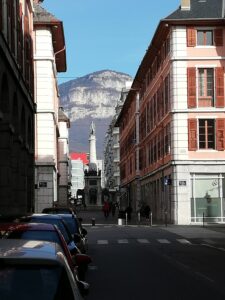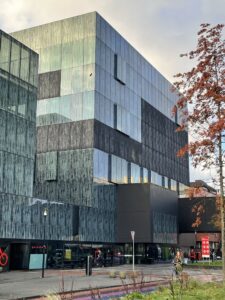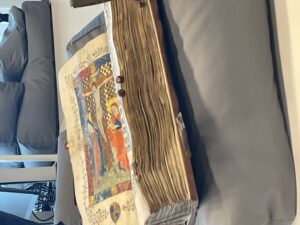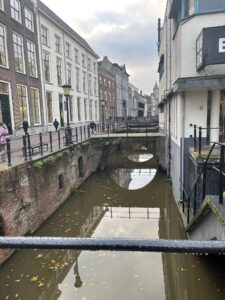[In English below.]
I nöd och lust, sägs det.
Arlanda sent på kvällen, än en gång väntar jag på det sista flyget till Åbo. Möjligen en efterhandskonstruktion, men visst var det färre människor den kvällen?
Nyheterna droppar allt tätare och känslan av osäkerhet börjar kännas konkret. Jag anstränger mej för att inte komma någon för nära. Men det är svårt att undvika kontakt på lokaltåget i Oslo. På hemvägen känns det skönt att invänta flyget i Gardermoen och några timmar senare få sitta nästintill ensam i F-terminalen på Arlanda.
Många med mig minns antagligen var ni befann er när WHO utlyste pandemin, den 13 mars 2020. Följande dag fick jag besked från den hastigt inkallade krisledningsgruppen: ”vi har just insett att du kom hem från utlandet, det är bäst att du tar 14 dagars karantän hemma, för vi måste vara försiktiga nu”. ”Troligen är jag den första vid ÅA som sattes i karantän”, tänkte jag hemma vid köksbordet, lite förnöjd över den särbehandlingen.
Några dagar senare möter vi alla de ödesmättade orden ”Jag skriver till er för att meddela att regeringens beslut att stänga utbildningsinstitutioner innebär att Åbo Akademi kommer att stänga sina dörrar: våra fysiska campus stängs och all kontaktundervisning upphör från och med onsdagen den 18 mars 2020”. Nästintill profetiskt uppmanade rektor Moira von Wright oss redan då med orden ”håll er på minst två meters avstånd från varandra”.
Det som hände de följande dagarna, veckorna, månaderna framstår i dagens perspektiv som en magnifik uppvisning av flexibilitet, solidaritet och vilja att kämpa med och för varandra, personal för studerande, lärare för kollega, doktorand för handledare, studerande för sin kurs, för varandra, för sin utbildning, ja alla för alla. Allt var lika förutsägbart kaotiskt som överskådligt naivt.
”Jag tror vi bäst behöver se framför oss en vision som kretsar kring balansakten mellan mod och tålamod”, skrev jag själv i mitt mail till personalen för ett år sedan och fortsatte: ”att ständigt tvingas övervinna oss själva och likafullt inte lägga ribban för högt. Mod och tålamod! Nu är det maraton som gäller. På måndagen börjar termin 4. Vila er under helgen!”
Utan träning är det få som springer ett maratonlopp. Utan träning förväntades vi springa ett sådant, och vi springer fortfarande. Entusiasm och känslan av solidaritet, snabba ryck, omformation av stöd, nya former för allt, möten, livet, studier, forskning, det lilla extra, tog vid och med rätt inställning går allt – en tid.
Att inse att våra första årets studerande – trots goda planer men givet pandemins irriterande framfart – nästan enbart har erfarenhet av ett platslöst campus och likafullt uthärda realiteten att antagningen av nya studerande igen sker i skuggan av det pågåendet undantaget är tungt. För att uttrycka det milt.
Ja, jag vill uttrycka mina tankar så milt som möjligt. Det ambivalenta finns där hela tiden, det nöts inte bort. Smärtan över att det förlorade inte finns och det tänkta, det planerade, inte blev – den smärtan lindras endast delvis av att vi trots allt lyckats rätt bra i att balansera säkerhet med att fortsätta vår verkamhet.
Våra första årets studerande har på ett plan klarat sina studier bättre än de föregående årens gulnäbbar. Under 2020 kunde vi utexaminera flera magisterar än på flera år. Samtidigt är det uppenbart att det tär på krafterna att springa maraton otränad. Allt fler är trötta, ensamma, uppgivna. Livsutrymmet snävas in, det sociala är utspätt, det rekreativa är, känns och förblir stumt.
I backspegeln noterar jag följande antagande: ”Nästa vecka kommer studeranden in i den nya studiemiljö vi skapat. De är som vi. Vissa är stora och utstrålar stort självförtroende, andra bryts nästan sönder av osäkerhet och ensamhet. Jag vet att ni gör allt ni kan för att förbereda er för det kommande, men minns att osäkerhet finns på båda sidorna”.
Jag är helt övertygad om att vi alla gjorde och tänkte så. Idag, ett år senare, finns osäkerheten säkert kvar, men den har ändrat form, kanske t.o.m. karaktär. Efter hundratals timmar av Zoom, Teams, Yammer, Mural, efter tusentals suckar och tankar fyllda med längtan efter kramar, fester, social samvaro, fri tillgång till rum, bibliotek, laboratorier, seminarier, vänner, debatter, flanörskap, ja allt vad ett campusliv för med sig, kvarstår den enkla frågan: när blir det nya bestående och i vilken form?
Ett år, ett liv, ditt och mitt liv. Festens undantag och undantagens olidliga vardag.
Undantag jo, hela tiden. Men vi har inte stängt, inte gett upp. Snarare tvärtom har efterfrågan på det vi gör ökat. Vi kan helt enkelt inte stänga, vi vill inte ge upp.
#Åakärlek är som andra slags kärlekar, tänker jag mig. Den hittar sina vägar och trotsar t.o.m. allt förnuft. Hoppas jag.
Mikael Lindfelt, prorektor
For better or for worse, it is said.
Arlanda late in the evening, once again I am waiting for the last flight to Turku. Possibly a post-construction, but I’m pretty sure there were fewer people that night?
The news is trickling in more and more often, and the feeling of insecurity is starting to feel concrete. I make an effort not to get too close to anyone. But it is difficult to avoid contact on the local train in Oslo. On the way home, it feels good to wait for the flight in Gardermoen Airport and a few hours later to sit almost alone in Terminal F at Arlanda.
Like me, many probably remember where you were when WHO announced the pandemic, on 13 March 2020. The following day, I received a message from the hastily convened crisis management team: “We have just noticed that you came home from abroad, it is best that you quarantine yourself at home for 14 days because we have to be careful now.” “I’m probably the first at ÅA to be quarantined,” I thought at home at the kitchen table, a little pleased with the special treatment.
A few days later, we all received those fateful words, “I am writing to you to announce that the government’s decision to close educational institutions means that Åbo Akademi University will close its doors: our physical campus will close and all contact teaching will cease starting on 18 March 2020”. Almost prophetically, Rector Moira von Wright urged us already then to “stay at least two meters apart”.
What happened in the following days, weeks, and months seems, from today’s perspective, like a magnificent display of flexibility, solidarity and willingness to fight with and for each other, personnel for students, teachers for colleagues, doctoral students for supervisors, students for their courses, for each other, for their education, yes everyone for everyone. Everything was as predictably chaotic as it was clearly naive.
“I think we really need to picture a vision that revolves around the balancing act between courage and patience”, I wrote in an email to the personnel a year ago and continued: “to constantly be forced to exceed ourselves while still not setting the bar too high. Courage and patience! Now it’s the marathon that counts. Term 4 begins on Monday. Rest during the weekend!”
Few people run a marathon without training. We were expected to run one without training, and we are still running. Enthusiasm and the feeling of solidarity, quickly adapting, regrouping of support, new forms of everything, meetings, life, studies, research, the little extra, took over and with the right attitude, everything works—for a while.
Realizing that our first-year students—despite good plans but given the pandemic’s annoying progress—have almost exclusively experienced a vacant campus, and still weathering the reality that the admission of new students is again happening in the shadow of the ongoing exception, is tough. To put it mildly.
Yes, I want to express my thoughts as mildly as possible. The ambivalence is always there, it does not let up. The pain of what was lost not existing and the thought of the plans that did not come to fruition—that pain is only partially relieved by the fact that we have, after all, succeeded quite well in balancing safety and continuing our activities.
Our first-year students have, in a way, managed their studies better than the freshmen of previous years. In 2020, we were able to graduate more master’s students than we had in several years. At the same time, it is obvious that running a marathon untrained is draining. More and more people are tired, lonely, feeling defeated. The space in which we live is limited, our social lives are watered down, our recreational activities are, feel and remain non-existent.
In hindsight, I note the following assumption: “Next week, the students will enter the new study environment we have created. They are like us. Some are optimistic and radiate great self-confidence, others are almost broken by insecurity and loneliness. I know that you are doing everything you can to prepare for the future, but remember that there is uncertainty on both sides”.
I’m absolutely convinced that we all acted and thought like that. Today, a year later, the uncertainty certainly remains, but it has changed form, perhaps even character. After hundreds of hours of Zoom, Teams, Yammer, Mural, after thousands of sighs and thoughts filled with the longing for hugs, parties, social gatherings, free access to rooms, libraries, laboratories, seminars, friends, debates, strolling around, yes everything a campus life brings with it, the simple question remains: when will the new become permanent and in what form?
One year, one life, your life and mine. The exception of the party and the unbearable everyday exceptions.
Exceptions, yes, all the time. But we have not closed, not given up. On the contrary, demand for what we do has increased. We simply cannot close, we do not want to give up.
#Åakärlek is like other kinds of love, I think. It finds its way and defies all reason. I hope.
Mikael Lindfelt, Vice-rector
 Det är alltid bra att åka på utbyte – det säger vi till studenterna, men det gäller också oss lärare. Man får möjlighet att undervisa i en ny omgivning, med nya, lite annorlunda studenter. Man får tala om sin forskning och berätta om något nytt, om något lite annorlunda till studenterna. Man lär sig nya saker. Man träffar nya människor och funderar vidare på det framtida samarbetet, både undervisnings- och forskningsmässigt. Man stärker gamla kontakter och skapar nya. Men det är inte bara professionellt värdefullt utan också på den mänskliga nivån, och dessutom är man också lite turist!
Det är alltid bra att åka på utbyte – det säger vi till studenterna, men det gäller också oss lärare. Man får möjlighet att undervisa i en ny omgivning, med nya, lite annorlunda studenter. Man får tala om sin forskning och berätta om något nytt, om något lite annorlunda till studenterna. Man lär sig nya saker. Man träffar nya människor och funderar vidare på det framtida samarbetet, både undervisnings- och forskningsmässigt. Man stärker gamla kontakter och skapar nya. Men det är inte bara professionellt värdefullt utan också på den mänskliga nivån, och dessutom är man också lite turist!







